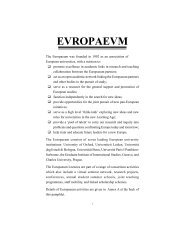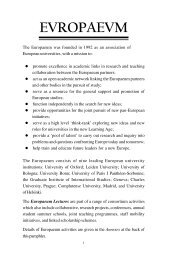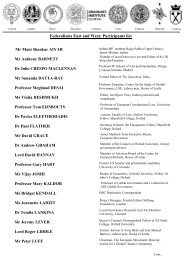to download a Special Report of this meeting - The Europaeum
to download a Special Report of this meeting - The Europaeum
to download a Special Report of this meeting - The Europaeum
You also want an ePaper? Increase the reach of your titles
YUMPU automatically turns print PDFs into web optimized ePapers that Google loves.
Strategies and Balance<br />
22<br />
people and bad architecture, and perhaps in the<br />
short term that is the next best thing <strong>to</strong> having<br />
good people and having good architecture. But I<br />
think we need <strong>to</strong> remind ourselves <strong>of</strong> the<br />
Reinhold Niebuhr quote about man’s inclination<br />
<strong>to</strong> injustice. People themselves can change, and<br />
organisations can change their people. If you<br />
want <strong>to</strong> have governance that endures over time,<br />
I think there is a case for both good corporate<br />
governance structures and principles <strong>to</strong> hold <strong>this</strong><br />
all <strong>to</strong>gether. Really, the aspiration should not be<br />
one or the other – good people or good architecture<br />
– but how do you pull it all <strong>to</strong>gether This is<br />
what we are doing at S&P in our analytical<br />
approach <strong>to</strong> governance issues.<br />
I am not going <strong>to</strong> elaborate in any detail, but<br />
let me present an outline <strong>of</strong> the framework that<br />
we have developed over the years <strong>to</strong> assess corporate<br />
governance, and I would like <strong>to</strong> mention a<br />
few points. First <strong>of</strong> all, we have four major components<br />
(ownership structure and external influences;<br />
stakeholder rights and relations; transparency,<br />
disclosure, and audit; and board structure<br />
and effectiveness. And there are further<br />
sub-categories under these broad categories. If<br />
you read our criteria or book (Governance and<br />
Risk, McGraw-Hill, 2005), you will see that <strong>this</strong><br />
can be broken down even further. <strong>The</strong> point is<br />
that governance, at least from our perspective,<br />
has <strong>to</strong> be a holistic assessment <strong>of</strong> multiple fac<strong>to</strong>rs.<br />
<strong>The</strong> discussion earlier <strong>this</strong> morning flagged<br />
up ownership as an issue, and I think it is going<br />
<strong>to</strong> crop up later <strong>this</strong> afternoon. Our starting<br />
point is ownership because it is almost like a fork<br />
in the road. <strong>The</strong> first question is who owns the<br />
company… it sounds like a simple question but<br />
sometimes the answer is not that simple, because<br />
it is not always that easy <strong>to</strong> know. But the point<br />
is that even if you do know, the next question is<br />
whether or not there is a controlling shareholder<br />
or a wide group <strong>of</strong> shareholders, which creates<br />
the two different agency problems that we need<br />
<strong>to</strong> be alert <strong>to</strong>. One <strong>of</strong> the issues about corporate<br />
governance codes is that they do not always<br />
address the point <strong>of</strong> ownership structure. This<br />
can be absolutely fundamental since the types <strong>of</strong><br />
governance risk manifest themselves differently<br />
in different situations, depending on whether<br />
ownership is concentrated or widely held.<br />
I am not going <strong>to</strong> belabour any other points; I<br />
will talk about the stakeholder issue if there are<br />
any questions, because I think it is a more complicated<br />
situation, but at the end <strong>of</strong> the day its<br />
part <strong>of</strong> the mix. Ultimately, we are focussing our<br />
own analysis on the interest <strong>of</strong> what we call<br />
financial stakeholders, which are shareholders<br />
and credi<strong>to</strong>rs, but you see there are issues <strong>of</strong><br />
transparency, disclosure, audit, board structure,<br />
and effectiveness which all need <strong>to</strong> be<br />
considered. <strong>The</strong> point is that we are considering<br />
long lists <strong>of</strong> fac<strong>to</strong>rs, and there are other<br />
people who do <strong>this</strong> sort <strong>of</strong> thing. It is not just<br />
a question <strong>of</strong> what list you have, but <strong>of</strong> how<br />
you do <strong>this</strong> type <strong>of</strong> analysis. How do you actually<br />
evaluate the company I think methodology<br />
is key.<br />
I believe the best way <strong>to</strong> do <strong>this</strong> is not <strong>to</strong><br />
start with a template, i.e. “here are the twenty<br />
governance issues, you can answer these questions<br />
right or wrong,” and expect that out <strong>of</strong><br />
the right-hand side <strong>of</strong> the equation comes a<br />
meaningful measure <strong>of</strong> a company’s corporate<br />
governance. I think that is the wrong way <strong>to</strong><br />
go about it, but there are lots <strong>of</strong> people who<br />
are trying <strong>to</strong> mechanically model governance,<br />
which can be fraught with peril.<br />
Ultimately, if you are going <strong>to</strong> try <strong>to</strong> assess a<br />
company’s corporate governance – it is more<br />
complicated and ultimately perhaps a bit more<br />
subjective – we believe you need <strong>to</strong> look at companies<br />
on a case-by-case basis. You need <strong>to</strong> talk<br />
<strong>to</strong> people who are actually part <strong>of</strong> the governance<br />
process at the firm in question, whether they are<br />
managers or direc<strong>to</strong>rs, and ideally you need <strong>to</strong><br />
get direc<strong>to</strong>rs in rooms by themselves, speaking<br />
candidly. It is important <strong>to</strong> avoid rigid box-ticking<br />
and the attitude <strong>of</strong> looking at governance<br />
simply for the sake <strong>of</strong> governance. <strong>The</strong> key really<br />
has <strong>to</strong> be how corporate governance facilitates<br />
execution <strong>of</strong> a company’s mission, how it might<br />
affect a company’s risk pr<strong>of</strong>ile, and how it might<br />
help the company build sustainable competitive<br />
advantage, which over time should lead <strong>to</strong><br />
greater levels <strong>of</strong> performance and greater levels<br />
<strong>of</strong> trust.<br />
If you are wondering about how <strong>this</strong> works in<br />
a multicultural context, we are doing <strong>this</strong> in Asia,<br />
North America, Latin America, and Europe; in<br />
developed markets and developing markets; and
















